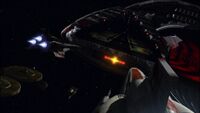Hands-on approach: Difference between revisions
m (Miniseries naming convention) |
m (Text replacement - "Lee "Apollo" Adama" to "{{callsign|Apollo}}") |
||
| (26 intermediate revisions by 8 users not shown) | |||
| Line 1: | Line 1: | ||
[[Image:Viperapproach 104 1080i.jpg|thumb|200px|The ''ball'' shown in the -+- configuration {{TRS|Act of Contrition}}.]] | |||
A '''hands-on approach''' refers to landing aboard a [[Battlestar (RDM)|battlestar]] under the pilot's full manual control, i.e. all flight control inputs come from the pilot, not from any automated system. This is a very difficult skill, requiring much practice to master. | |||
There are two kinds of hands-on approaches: the [[Action Stations|condition three]]-mode landing, as performed by Lee Adama when first arriving on ''Galactica'' {{TRS|Miniseries}}; and the high-speed [[combat landing]]. | |||
At the time of the surprise [[Cylon Attack]], complacency allows battlestars to routinely use computerized auto-landing systems to network with a ship's controls and guide it into the flightpods. On ''{{RDM|Galactica}}'', [[William Adama]]'s orders make hands-on approach the only accepted landing procedure. The uniqueness of this policy is evident from {{callsign|Apollo}}'s confusion when he is instructed to land his [[Viper (RDM)|Viper]] Mk VII manually {{TRS|Miniseries}}. | |||
Commander Adama has banned the use of auto-landing systems aboard ''Galactica'' because it would expose the computers to vulnerabilities exploited by the Cylons in the first war (such as [[Cylon computer virus|viruses]]), part of his no-networked-computers policy to protect against future [[Cylons (RDM)|Cylon]] attacks. | |||
[[ | [[Image:Handsonapproach.jpg|thumb|200px|Captain [[Lee Adama]] completes a hands-on approach in his [[Viper (RDM)|Viper]] Mk. VII {{TRS|Miniseries}}.]] | ||
A typical [[wireless]] | A typical [[wireless]] exchange for a hands-on approach between [[LSO|Landing Signal Officer]] and pilot might go like this: | ||
:'''LSO:''' " | :'''LSO:''' "[[Viper 791|Viper seven niner one]] / ''Galactica'', you are cleared for approach ... Speed one seven five, port bay, hands-on approach, checkers green, call the ball<ref>The "ball" refers to the arrangement of crossed navigational lights at the lip of the [[landing bay]], and/or the visual cue on a cockpit display (as seen in [[Louanne Katraine|Kat's]] Viper in "[[Act of Contrition]]"). The pilot would use this to adjust his/her glideslope for a proper approach into the flight pod. The phrase "I have the ball" informs the LSO that the pilot has acquired this visual cue and is beginning the final approach.</ref>." | ||
:''' | :'''Pilot:''' "Copy. I have the ball." | ||
{{clear}} | |||
== References == | |||
{{reflist}} | |||
[[Category:A to Z]] | [[Category:A to Z]] | ||
[[Category:Technology]] | [[Category:Technology]] | ||
[[Category:Terminology]] | [[Category:Terminology]] | ||
[[Category:RDM]] | |||
[[Category:TRS]] | |||
[[fr:Approche manuelle]] | |||
Latest revision as of 18:40, 11 February 2024

A hands-on approach refers to landing aboard a battlestar under the pilot's full manual control, i.e. all flight control inputs come from the pilot, not from any automated system. This is a very difficult skill, requiring much practice to master.
There are two kinds of hands-on approaches: the condition three-mode landing, as performed by Lee Adama when first arriving on Galactica (TRS: "Miniseries"); and the high-speed combat landing.
At the time of the surprise Cylon Attack, complacency allows battlestars to routinely use computerized auto-landing systems to network with a ship's controls and guide it into the flightpods. On Galactica, William Adama's orders make hands-on approach the only accepted landing procedure. The uniqueness of this policy is evident from Lee "Apollo" Adama's confusion when he is instructed to land his Viper Mk VII manually (TRS: "Miniseries").
Commander Adama has banned the use of auto-landing systems aboard Galactica because it would expose the computers to vulnerabilities exploited by the Cylons in the first war (such as viruses), part of his no-networked-computers policy to protect against future Cylon attacks.

A typical wireless exchange for a hands-on approach between Landing Signal Officer and pilot might go like this:
- LSO: "Viper seven niner one / Galactica, you are cleared for approach ... Speed one seven five, port bay, hands-on approach, checkers green, call the ball[1]."
- Pilot: "Copy. I have the ball."
References
- ↑ The "ball" refers to the arrangement of crossed navigational lights at the lip of the landing bay, and/or the visual cue on a cockpit display (as seen in Kat's Viper in "Act of Contrition"). The pilot would use this to adjust his/her glideslope for a proper approach into the flight pod. The phrase "I have the ball" informs the LSO that the pilot has acquired this visual cue and is beginning the final approach.